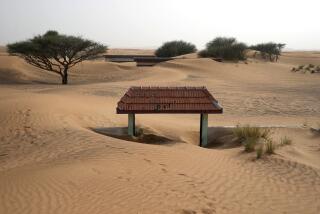Development Supersedes Archeology : New Wealth Hides Mystery of Queen of Sheba
- Share via
MAREB, North Yemen — This green valley on the edge of the great sand lake of the Empty Quarter in northeastern Yemen exudes history, yet its mysteries may never fully unfold.
Mostly buried under the trickling river bed and sprouting farm acreage downstream from a dam here are the remnants of a civilization ruled by the most powerful woman who ever lived on the Arabian Peninsula--the Queen of Sheba.
The Mareb Dam is a modern version of one built 3,000 years ago that was partly responsible for the prosperity of Sheba. The new dam and irrigation system, completed in 1985, and the recent discovery of oil near here have brought a welcome renewal of prosperity to Mareb, which locals compare to the fabled riches of ancient times.
But the demands of development seem likely to supersede those of archeology and--combined with the paucity of North Yemen government funds for archeological work--may put another layer of earth over the Queen of Sheba’s empire.
Abandoned City
The old city of Mareb sits abandoned on a mound, under which may lie the foundation of Queen Bilqis--Sheba’s given name. The crooked skyline of its mud houses can be seen shimmering in the noonday heat from 10 miles away. Only a handful of poor squatters have dared live within its cracked and crumbling walls during the 25 years since Egyptian bombers pummeled them during a civil war that wracked North Yemen between 1962 and 1969.
“This used to be the greatest city on the Arabian Peninsula,” said Ahmad A. Moharam, a specialist on Mareb who was formerly with North Yemen’s Ministry of Culture. He said there has been no excavation here since the revolution in 1962 that ousted a feudal monarchy. “We don’t have the staff to do it. We don’t have the money,” Moharam said.
The central government recently announced that it would accept proposals for archeological excavation around Mareb. But the pace of new commercial and agricultural development appears to be overwhelming that possibility. Farming companies and wealthy merchants from the capital of Sanaa and the commercial center of Taiz are buying up tracts that will benefit from the water flow that the new dam provides.
It was the ancient dam, built about the Queen of Sheba’s time in the 10th Century BC, that made it possible for civilization to flourish here. An alabaster monument found near the dam and dated AD 420 details a massive reconstruction effort after floods had breached the barrier. Yemen’s tribes gathered 20,000 men, 3,000 camels, 50,000 sacks of wheat and 20,000 sheep in a sprawling work camp to repair the old dam one last time before it collapsed again in the next century. The locks of the ancient dam still stand.
Population Boom
Today, oil exploration and production on concessions of the Hunt Oil Co. have helped swell the local population from 200 to more than 7,000. Unfortunately, the bulldozers that have been putting in new roads and leveling new farmland have paid little heed to the signs of the ancient structures lying beneath them.
All the growth is welcome to the tribal clans of Mareb. “We had wealth in ancient times with Sheba. Now it will come again,” said the provincial governor, Dirham Hakimi.
But as one Westerner who makes a hobby of Mareb lore said, “Unless the government’s attitudes change toward the archeological community, we may never find out about the people who lived here.”
In ancient times, Mareb was called “the land of the two paradises,” for the farms stretched along either side of the Dhana River here. Caravans with thousands of camels loaded with gold, frankincense and myrrh assembled for the long journey north along the fabled Incense Route in eastern Arabia to the markets and port of Gaza, in what is now the Israeli-occupied Gaza Strip. The ancient Latin-speaking world called the southern Arabian Peninsula Arabia Felix, or fortunate Arabia, because of the treasure that came from here.
One Major Expedition
The only major archeological expedition to Mareb was in late 1951 and early 1952, when the American Foundation for the Study of Man received permission from the Yemeni monarch to excavate the Queen of Sheba’s temple to the moon. But the suspicious ruler and Yemeni tribesmen decided that the work was harming the ruins and chased the team out to British-protected South Yemen.
Before the flight, Frank P. Albright, leader of the expedition, wrote that “the little city of Mareb is all that remains of . . . Mariaba, once a great and prosperous caravan city and capital of the ancient Kingdom of the Sabeans.”
He found the temple covered with sand and noted that on the eastern wall of the structure, where in 1888 a German scholar had counted 13 courses of inscriptions, only seven courses remained and much of the temple wall had disappeared stone by stone.
History has added little to understanding of the queen’s empire beyond her domination of the incense trade. In effect, many scholars believe, this caravan queen had cornered the import-export market for incense and myrrh brought from Somalia, Ethiopia and India, which she then shipped north to customers who believed that her kingdom was the only source of these rare and essential commodities for the temples of the Mediterranean empires.
So much mystery surrounded the trade secrets of her kingdom that the Roman historian Herodotus wrote in the 5th Century BC that “Arabia is the only country which produces frankincense . . . (and) the trees bearing the frankincense are guarded by winged serpents of small size and various colors.” Some scholars have suggested that the tale of “winged serpents” guarding Yemeni frankincense trees were invented by the shrewd Sabean regime to ward off adversaries to its monopoly on the incense trade.
Visit to Solomon
“They were buying a lot of incense from Somalia and India and making everybody think it came from Yemen,” Moharam said.
The few biblical references to her 10th-Century BC kingdom cropped up only when Queen Bilqis appeared to be protecting her commercial interests. When the Hebrew King Solomon established his own trade route to the south Arabian ports by assembling a Red Sea fleet manned by Phoenician sailors, the Bible records the Queen of Sheba’s famous visit to Solomon’s court.
She arrived with “a very great retinue, with camels bearing spices and very much gold and precious stones,” the Old Testament says.
The Bible is not clear on how she and Solomon settled this trade dispute. But the settlement appears to have been amicable because the Book of Kings notes: “King Solomon gave the Queen of Sheba all that she desired. Whatever she asked was given to her by the bounty of King Solomon. So she turned and went back to her own land.”
More to Read
Sign up for Essential California
The most important California stories and recommendations in your inbox every morning.
You may occasionally receive promotional content from the Los Angeles Times.













